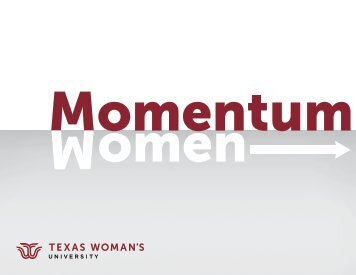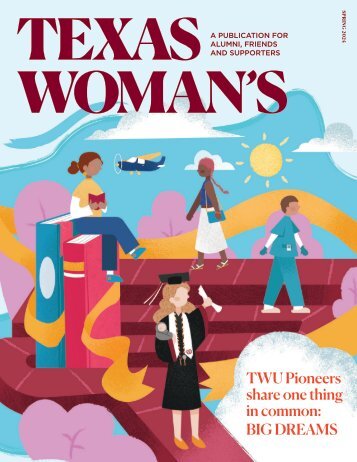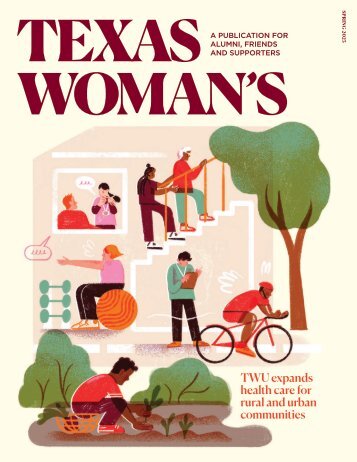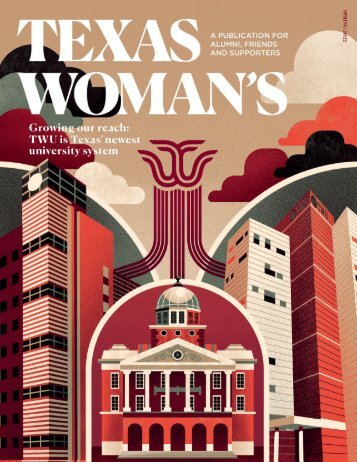Texas Woman's Magazine - Spring 2022
The inaugural issue of Texas Woman's University Magazine
Texas
Texas Woman’s senior Jennifer Romero landed the internship of her dreams when she worked two summers with Dallas-based LATINA Style magazine, conducting research and data analysis and ironing out logistics for a national conference in Washington, D.C. 2 TEXAS WOMAN’S
The networking and mentoring she gained from her professors helped make Romero a shoo-in for the job. Three hundred miles south, in San Antonio, Colette Shrader’s business making prosthetic body parts—such as eyes, ears and noses—received a major boost through a ,000 grant from Texas Woman’s Center for Women Entrepreneurs that supported her company when it was struggling during the pandemic. The grant was one of 100 awarded to small, womenowned businesses in the state that encountered hardship in 2020 because of COVID-19. Romero and Shrader have never met—and they work in distinctly different fields—but their common Texas Woman’s network has been critical to their professional growth. It’s the kind of influence Texas Woman’s has had on people’s lives for more than a century. Now the university is preparing to scale its impact on Texas in an even bigger way. A HISTORY-MAKING NEW SYSTEM A new Texas law passed in summer 2021 established Texas Woman’s as the state’s seventh public university system and the first in the nation with a woman-focused mission. While the university still must contend with organizational and operational restructuring as it transitions to a system, Texas Woman’s is poised to expand programming, accelerate community and corporate partnerships, elevate philanthropy and have a greater role in preparing Texas’ workforce. “The mission of Texas Woman’s remains the same—we are still about transforming lives, cultivating leaders and inspiring excellence in an inclusive, diverse environment— but now we have a bigger and better platform from which to achieve that,” said Chancellor Carine Feyten, whose role as president of the Denton-based university will remain in place even after the other two locations hire leaders and establish independent status. “This elevates Texas Woman’s stature as a university system committed to developing women leaders in business, health, education, science, the arts and public service.” Perhaps the most significant structural change will be the addition of new leadership at the Dallas and Houston campuses, which will allow those institutions to operate with greater independence and forge corporate and community partnerships of their own, Feyten said. Although it still may take years for the new leadership to come on board, becoming a system is a major step toward reaching that goal. TIMED RIGHT FOR WOMEN The timing for this scale-up could not be better, some academic experts say, because the pandemic created widespread economic turmoil that was especially disadvantageous to women. In September of 2020 alone, four times as many women as men dropped out of the U.S. workforce, according to federal labor statistics. The toll on working mothers was particularly evident, as strains on the child care system became more acute. That’s why woman-focused universities—with their unique environments that prime women to succeed—are needed more than ever. “Women’s universities and colleges are intentional about helping students find their voice, speak up and advocate for themselves and for change,” said Emerald Archer, Ph.D., executive director of the Women’s College Coalition, a collaboration of higher education institutions in the United States and Canada. “And importantly, women’s colleges have a strength and focus when it comes to creating social mobility for women in the most at-risk populations.” THE DRIVE TO DREAM BIGGER It’s imperative that institutions focus on women’s leadership skills, which builds a path to C-suite careers, said Mary Anne Alhadeff, executive director of TWU’s Jane Nelson Institute for Women’s Leadership. The institute oversees three centers aimed at increasing women’s roles in business and civic leadership. With Texas Woman’s operating under a structure that encourages more partnerships, philanthropy and programming, the new system will produce even more opportunities for women in the labor market, she said. “Both men and women aspire to become executives, but far fewer women believe they will achieve this goal,” Alhadeff said. “Women’s leadership programs provide the critical education women need to build their confidence and attain those top positions.” The state-wide network of women associated with the institute can pay great dividends. TWU helps women build a network of peers and mentors that will be beneficial long after they graduate, she said. “The evolving work environment offers great opportunity for women to assume leadership positions,” Alhadeff added, “provided they are prepared to do so.” TEXAS WOMAN’S 3
- Page 6 and 7: What Is Our Next History-Making Mov
- Page 8 and 9: DONOR IMPACT Down to a Science Brin
- Page 10 and 11: DONOR IMPACT Doswell Support Contin
- Page 12 and 13: WHAT IF? What if TWU trained and gr
- Page 14 and 15: RESEARCH THAT MATTERS A Place of He
- Page 16 and 17: 1968 The Graduate Research Building
- Page 18 and 19: TWU IS EVERYWHERE When the pandemic
- Page 20 and 21: NEWS ROUNDUP Campus by Campus Learn
- Page 22 and 23: Pioneers > BINDU VARGHESE ’01 ,
- Page 24 and 25: KIMBERLY GOMEZ ’25 AND BRITTNEY M
- Page 26 and 27: True Grit Putting more lives in tur
- Page 28: Texas Woman’s University Office o
Inappropriate
Loading...
Mail this publication
Loading...
Embed
Loading...
Chancellor Office Publications
Texas Womans Magazine
Current Viewbooks
Viewbook Archive
Texas Woman's University
304 Administration Dr.
Denton, TX 76204
940-898-2000
© 2021 Texas Woman's University




























